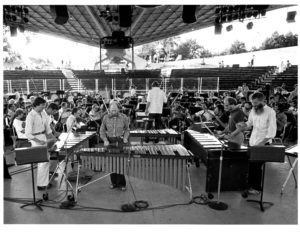
NEXUS reh. w/ E.Kunzel, Ontario Place
1980 SYMPHONY POPS and ERICH KUNZEL We were developing repertoire for symphonic pops concerts mostly centered around orchestrations of the novelty ragtime music that Bob Becker and @BillCahn had arranged. John Wyre’s and Bill’s orchestra positions in Toronto and Rochester connected them with Erich Kunzel who was becoming a leading pops conductor in North America. He was a frequent guest with both orchestras. Kunzel was interested in our arrangements which featured solo xylophone with two marimbas. In 1980 he conducted the 1st performance of this music on a pops concert with the Toronto Symphony at Ontario Place in Toronto. These ragtime arrangements along with Bill’s theatre orchestra repertoire eventually became our “From Rags to Riches” pops program. When Kunzel would guest conduct in Rochester, Bill says, “Kunzel’s programs were always percussion heavy, and it was a normal occurrence for me to spend hours and hours working on the preparation of thick books of printed percussion parts prior to his first rehearsals – erasing old pencil markings, re-marking and assigning instruments clearly, photocopying, etc.” When Kunzel passed away in 2009, Bill remembered him: “loud and direct…He loved beer and he enjoyed showing off his ability to chug an entire yard-glass of beer in one sustained gulp to the delight of all witnesses.” Meanwhile, Bill’s 10-year research project on old xylophone recordings culminated in his book “The Xylophone in Acoustic Recordings, 1877-1929”, a 264 page discography! The book lists many recordings by George and Joseph Green under their own names and under many pseudonyms and with numerous bands having many separate names. The earliest records by George Green were made for the Edison company and contained transcriptions of classical overtures. Green’s own compositions came later. Read more in Erich Kunzel Remembered: https://www.nexuspercussion.com/2009/09/erich-kunzel-remembered/
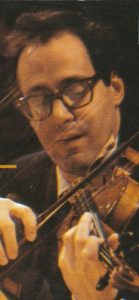 1980 PAUL ZUKOVSKY and JO KONDO In August, we headed up north to John Wyre’s geodesic dome in Norland ON where we recorded Jo Kondo’s “Under the Umbrella” for violinist Paul Zukovsky’s CP2 recordings. Each movement of the piece was recorded in one take, no edits. The recording was made using one microphone; we had constructed a pentagonal rack, from each section of which hung each player’s five “almglocken”. Paul Zukovsky was a controversial figure. When he died in Hong Kong in 2017 his New York Times obituary was unkind to say the least, and several posted tributes to counter it! But Robin Engelman wrote in 2013, “Paul Zukovsky and I remain long distance friends…From my perspective, his major contributions to 20-21st century music are his interpretations of violin music, his conducting and the Musical Observations Inc. CP2 digital recordings which he owns and which demonstrate both his playing and conducting skills…The CP2 catalogue consists of 18 splendid CDs encompassing works from our two most recent centuries. All containing rare musical gems played and produced with the highest professional standards.” The original LP was number CP2 #11. The recording was re-released by CP2 recordings in 2012 on an album that also features Jo Kondo’s orchestral works Mulberry, In the Woods, and In Summer performed by the Tokyo Metropolitan Symphony Orchestra under Paul Zukovsky. The recording was remixed and re-mastered by Paul Zinman at Soundbyte Productions, Inc., NYC. The recording engineer was Yukio Kojima. Paul Zukofsky made the edit choices and supervised the pre and post production. The new release is CP2 #123. We would work with Paul again over the next couple of years.
1980 PAUL ZUKOVSKY and JO KONDO In August, we headed up north to John Wyre’s geodesic dome in Norland ON where we recorded Jo Kondo’s “Under the Umbrella” for violinist Paul Zukovsky’s CP2 recordings. Each movement of the piece was recorded in one take, no edits. The recording was made using one microphone; we had constructed a pentagonal rack, from each section of which hung each player’s five “almglocken”. Paul Zukovsky was a controversial figure. When he died in Hong Kong in 2017 his New York Times obituary was unkind to say the least, and several posted tributes to counter it! But Robin Engelman wrote in 2013, “Paul Zukovsky and I remain long distance friends…From my perspective, his major contributions to 20-21st century music are his interpretations of violin music, his conducting and the Musical Observations Inc. CP2 digital recordings which he owns and which demonstrate both his playing and conducting skills…The CP2 catalogue consists of 18 splendid CDs encompassing works from our two most recent centuries. All containing rare musical gems played and produced with the highest professional standards.” The original LP was number CP2 #11. The recording was re-released by CP2 recordings in 2012 on an album that also features Jo Kondo’s orchestral works Mulberry, In the Woods, and In Summer performed by the Tokyo Metropolitan Symphony Orchestra under Paul Zukovsky. The recording was remixed and re-mastered by Paul Zinman at Soundbyte Productions, Inc., NYC. The recording engineer was Yukio Kojima. Paul Zukofsky made the edit choices and supervised the pre and post production. The new release is CP2 #123. We would work with Paul again over the next couple of years.
Read more: an interesting discussion of Jo Kondo’s music here; A tribute to the complex Paul Zukofsky at https://languagelog.ldc.upenn.edu/nll/?p=33394#more-33394; The CP2 catalogue: http://www.musicalobservations.com/recordings/index.html
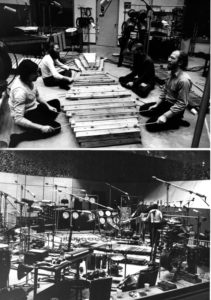
The recording session
1980 MUSIC OF NEXUS LP John Wyre writes, “In 1980 NEXUS produced an LP called “The Music of NEXUS.” The recording included a wide spectrum of music that reflected our current repertoire and included a piece we called “Kobina”, dedicated to our friend and mentor, Abraham Kobina Adzenyah. (Kobina actually means Tuesday and refers to Abraham’s day name as he was born on a Tuesday.) The music was based on a recreational dance of the Ewe people of southeastern Ghana and Togo called “Gahu”. NEXUS has never presented the music of other cultures with any assumptions of authenticity, and often we add new and different voices to the music as our imaginations are inspired to participate.’ The album was released the next year to celebrate our 10th anniversary year.
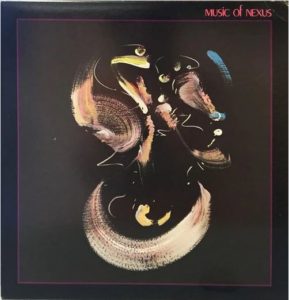 One of Michael Craden’s paintings graces the cover. Bill says, “Michael painted a series called ‘Nexus Suite’, with 1 painting named after each member of Nexus. I don’t remember which member’s name is associated with the Music of Nexus LP cover!” Bob Becker did the layout and design and Bob tells us that the LP was manufactured at World Records, which used to be in Bowmanville, Ontario. Some of the other cuts on the album were The Birds, April Showers, Unexpected Pleasures, and Amazing Space.
One of Michael Craden’s paintings graces the cover. Bill says, “Michael painted a series called ‘Nexus Suite’, with 1 painting named after each member of Nexus. I don’t remember which member’s name is associated with the Music of Nexus LP cover!” Bob Becker did the layout and design and Bob tells us that the LP was manufactured at World Records, which used to be in Bowmanville, Ontario. Some of the other cuts on the album were The Birds, April Showers, Unexpected Pleasures, and Amazing Space.
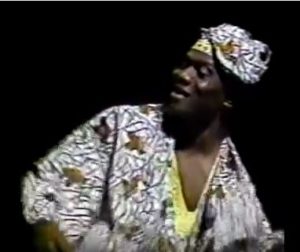 1981/82 A TENTH ANNIVERSARY CONCERN May 1981 was our 10th Birthday. We marked the occasion that season with a series of concerts at the St. Lawrence Centre in Toronto. The first (May’81) featured poet Earle Birney and would lead to a 3-vol. recording with him the following year. Another (May ’82) featured Bob Becker and our ragtime repertoire. Another was with harp virtuoso Judy Loman, and this too would lead to a future recording with her. The March’82 concert featured Abraham Adzenyah and the music of Africa. Through our co-productions with the CBC we were able to have good tapes of these anniversary concerts. In 1980 we had released an album that included “Kobina”, dedicated to Abraham – the music based on a recreational dance of the Ewe people of Ghana and Togo. John Wyre takes up the story: “In 1982 I received a call from Abraham. He was very upset…we had a major problem to resolve. His Ewe friends had heard our LP with the recording of “Kobina”…According to their cultural tradition at the time, and naively unbeknownst to NEXUS, it was against tradition to record and/or receive any commercial gain from their music. They were holding Abraham, as our teacher, responsible…A long conversation ensued that touched on the process of teaching…the inability of the mentor to control the use and evolution of insight within the student, on cultural appropriation, and many other ramifications of the incident. I promised Abraham I would write to his Ewe friends apologizing for our actions and vindicating Abraham of any responsibility. I sent the letter and included a copy of our 1981/82 anniversary concert tape that featured the music of Africa and asked Abraham to play it for his Ewe friends. When I asked Abraham how his friends had reacted to our tape, he smiled and said that they had cried and told him to bring NEXUS to Ghana to help them teach their children.”
1981/82 A TENTH ANNIVERSARY CONCERN May 1981 was our 10th Birthday. We marked the occasion that season with a series of concerts at the St. Lawrence Centre in Toronto. The first (May’81) featured poet Earle Birney and would lead to a 3-vol. recording with him the following year. Another (May ’82) featured Bob Becker and our ragtime repertoire. Another was with harp virtuoso Judy Loman, and this too would lead to a future recording with her. The March’82 concert featured Abraham Adzenyah and the music of Africa. Through our co-productions with the CBC we were able to have good tapes of these anniversary concerts. In 1980 we had released an album that included “Kobina”, dedicated to Abraham – the music based on a recreational dance of the Ewe people of Ghana and Togo. John Wyre takes up the story: “In 1982 I received a call from Abraham. He was very upset…we had a major problem to resolve. His Ewe friends had heard our LP with the recording of “Kobina”…According to their cultural tradition at the time, and naively unbeknownst to NEXUS, it was against tradition to record and/or receive any commercial gain from their music. They were holding Abraham, as our teacher, responsible…A long conversation ensued that touched on the process of teaching…the inability of the mentor to control the use and evolution of insight within the student, on cultural appropriation, and many other ramifications of the incident. I promised Abraham I would write to his Ewe friends apologizing for our actions and vindicating Abraham of any responsibility. I sent the letter and included a copy of our 1981/82 anniversary concert tape that featured the music of Africa and asked Abraham to play it for his Ewe friends. When I asked Abraham how his friends had reacted to our tape, he smiled and said that they had cried and told him to bring NEXUS to Ghana to help them teach their children.”
The words of John Wyre come from his book “Touched By Sound”.
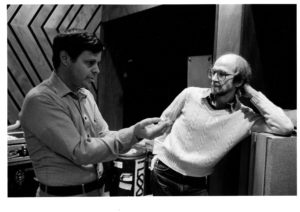
Robin and Russell
1981 A BRIDGE TOO FAR? In September 1981 The West German Radio Company (WDR) in Köln (Cologne) invited NEXUS to perform on a percussion festival. They offered to bring us all the way from Canada to Köln for just one concert! Our program: Cage’s Third Construction, some xylophone rags, and works by NEXUS members. One of the latter was Bridge composed by Robin Engelman. Bill takes up the story: “Although the rest of us in NEXUS had given Robin a lot of grief in rehearsing his piece, most of our commentary was pure jive. We had always been rather hard on each other that way. If one of us was going to bring something new into the group…he had better be prepared to withstand various kinds of challenges from the others. We have always been brutally honest with each other, but that honesty also formed the foundation for the trust that we shared….I always enjoyed playing Bridge. For me the piece is a sound festival, a garden of sonic delights. Every sound in it seems to me to be distinctive and loaded with energy. Inevitably something in the piece would always grab me by surprise and make me laugh….The laugh response, I have come to respect it, and it is not at all unusual for me to experience it many times during NEXUS concerts…In Germany the audience turned out to be a serious one, and as we began playing Robin’s piece, I unexpectedly found myself completely abandoned in the music…As the music reached its wacked-out climax, with me blowing full force on a harmonica and trying to bend the pitch in every conceivable direction, my stomach started to gurgle…I was wrenched by some great force from the cocoon of the music, I was suddenly detached from the concert…I began to laugh and I rapidly lost all control…A glance at the audience, sitting there in all seriousness only compounded my situation and incited more laughter. I laughed to the point of pain and I didn’t manage to fully regain control until the piece reached its conclusion…The Cologne performance of Bridge received a polite round of applause.”
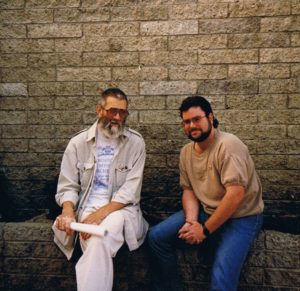
John Wyre & Ray 1988 Australia
1981 RAY DILLARD and TOURING WITH TRUNKS Bill Cahn says, “It is essential to include Ray Dillard in any discussion about NEXUS. Ray became the Business Manager for NEXUS in 1998, but we first met him in 1981 during another crazy touring year.” From Toronto where we performed in a wide variety of spaces (St Lawrence Centre, Toronto Free Theatre, the Grange Studio, John’s geodesic dome, and the Mother Necessity Jazz Workshop ) we bopped to a one-nighter in Germany (!) to Illinois, Oklahoma, Dallas TX and then headed home via PASIC in Indianapolis. It was in Dallas at the Southern Methodist University where we met Ray. John Wyre and Bill Cahn had each “had a go” at managing NEXUS and the task had become daunting. John wrote, “Enter Ray Dillard to the NEXUS family, functioning as a positive facilitator in NEXUS meetings as well as managing our business affairs.” Bill Cahn says, “With his combined skills as a percussionist and recording engineer/producer, Ray has performed with NEXUS on occasion, and he has been creatively involved in virtually every compact disc and video made by the group.” John Wyre continued, “Ray is a very special character: a fine percussionist, a sensitive musician, a wizard with the technology of computers and the recording industry, and he possesses extraordinary people skills. He’s produced most of our recordings and has a deep understanding of our music, our instruments, and our individual characters.” Ray is a whiz with logistics, ins and outs of truck packing and unpacking, load-ins and load-outs, cost estimates and budgets, and he has toured with NEXUS as road manager – no small feat! We have always required that our own instruments travel with us and that includes the big keyboard instruments, 2 marimbas, a vibraphone, a xylophone. Somewhat impractical but as Bill Cahn says, “We know the sounds and nuances of our instruments, and those specific sounds are a fundamental aspect of the NEXUS aesthetic…[As well], many of the percussion instruments used in the NEXUS repertoire are rare and one-of-a-kind…Consequently, a high percentage of every NEXUS tour budget has been devoted to instrument shipping – air freight, truck rental, driving expenses, truck driver as needed, etc.” Many a story can be told of “driving in the truck with Ray”. We should also mention Bob Becker’s work – he has looked after customs and carnets – not easy! Bill Cahn has been in charge of instrument insurance. In addition to the instruments kept in our own studios, Tower Storage has been the caretaker of our instruments in Toronto between gigs. And we must thank @WoodshedPercussion for their many acts of cartage and kindness over the years. What a team!
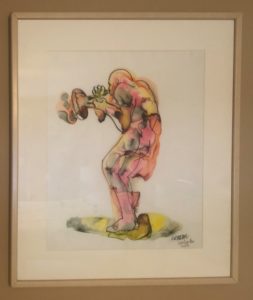 1982 TRIBUTE TO MICHAEL CRADEN 1982 began on a very sad note. One of our founding members, Michael Craden, passed away in January, succumbing to a swift-hitting cancer at age 41. Our concert at PASIC’81 had been his last with NEXUS.
1982 TRIBUTE TO MICHAEL CRADEN 1982 began on a very sad note. One of our founding members, Michael Craden, passed away in January, succumbing to a swift-hitting cancer at age 41. Our concert at PASIC’81 had been his last with NEXUS.
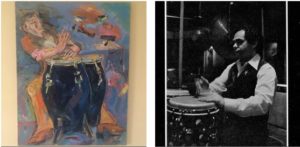 Bill says, “Michael was formally educated in the visual arts – painting and sculpture – but he was entirely self-taught as a musician. When NEXUS was in its formative period in the late 1960s, Michael was living in Toronto, though he had previously worked with Harry Partch in California. In Toronto he was performing with the Boss Brass and in his own ensemble, I Ching. It wasn’t long before he made the acquaintance of John Wyre….”
Bill says, “Michael was formally educated in the visual arts – painting and sculpture – but he was entirely self-taught as a musician. When NEXUS was in its formative period in the late 1960s, Michael was living in Toronto, though he had previously worked with Harry Partch in California. In Toronto he was performing with the Boss Brass and in his own ensemble, I Ching. It wasn’t long before he made the acquaintance of John Wyre….”
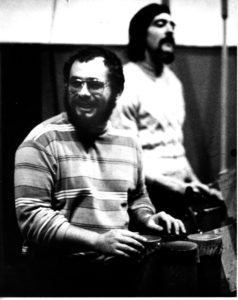 That 1st night when Michael knocked on John’s door, he brought greetings from Emil Richards. Richards credits Craden as being “one of the forebearers of the free-form art movement of the early ’60s.” Inspired by Indian tabla rhythms, he experimented with numerical patterns, mathematical ratios, microtonal tuning, and rhythm, as it related to art. John Wyre said that Michael’s “improvisational skills were magical. He found places to play that were unimaginable, charming, and challenging, on his way to new horizons in spontaneity.”
That 1st night when Michael knocked on John’s door, he brought greetings from Emil Richards. Richards credits Craden as being “one of the forebearers of the free-form art movement of the early ’60s.” Inspired by Indian tabla rhythms, he experimented with numerical patterns, mathematical ratios, microtonal tuning, and rhythm, as it related to art. John Wyre said that Michael’s “improvisational skills were magical. He found places to play that were unimaginable, charming, and challenging, on his way to new horizons in spontaneity.”
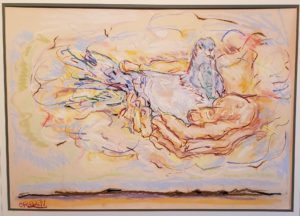 Michael was a gifted sculptor and painter with showings in Los Angeles and Toronto. Three of Michael’s works – all associated with percussion – have been donated to the PAS Museum by the Celeste and Emil Richards Estate. They are entitled Bliss Conscious Vibe Player, The First Mallet Player, and Stone Marimba Player. As Richards wrote in 1996, “My favorite memory of him is that most of his artwork made me laugh. There was such humor in his art. And there was nothing he couldn’t do rhythmically… a very talented man.” Bill Cahn says, “Michael was driven to paint, like a salmon is driven to swim upstream at spawning time. He created hundreds of works in a number of media and his training and skill permitted him to produce works of art containing the same powerful qualities as his music; his paintings never blended in with the surroundings and they always demanded attention. He was continually bringing his newest works to NEXUS.” The Art Gallery of Peel here in Canada in downtown Brampton, Ontario, has a Michael Craden work in its permanent collection, and you will find several of his works attached to this post, from the personal collections of NEXUS members. Bill remembers one of Michael’s comments: “If you ever have to choose between a work of art that you like and a work of art that you don’t like, always choose the one you don’t like. That’s the one that will help you to grow.” Canadian artist Ed Schleimer commented to us that “Michael took me from an illustrative graduate of the Ontario College.of Art, Toronto, to a serious painter after about 6 months of night sessions in drawing & painting at ‘3 SKULES’/Brunswick Avenue, Toronto. I had a tin ear for music but reverberated with his instruction in paint. ‘Do what I say, and we’ll see!’” Sometime in the mid-1970s Michael gave Bill a hand-typed self-published book he had written titled, “The Artist’s Advocate,” in which he had compiled his inspirational thoughts on the nature of art and artists. Bill says the book “conveys a deep sense of Michael’s aesthetics.” You can read it for yourself at https://bit.ly/3a4sGBP. As Michael wrote, “One must be able to feel secure in one’s solitude. One must not feel crushed by the burden of time nor feel terrified by the swiftness of its passing.”
Michael was a gifted sculptor and painter with showings in Los Angeles and Toronto. Three of Michael’s works – all associated with percussion – have been donated to the PAS Museum by the Celeste and Emil Richards Estate. They are entitled Bliss Conscious Vibe Player, The First Mallet Player, and Stone Marimba Player. As Richards wrote in 1996, “My favorite memory of him is that most of his artwork made me laugh. There was such humor in his art. And there was nothing he couldn’t do rhythmically… a very talented man.” Bill Cahn says, “Michael was driven to paint, like a salmon is driven to swim upstream at spawning time. He created hundreds of works in a number of media and his training and skill permitted him to produce works of art containing the same powerful qualities as his music; his paintings never blended in with the surroundings and they always demanded attention. He was continually bringing his newest works to NEXUS.” The Art Gallery of Peel here in Canada in downtown Brampton, Ontario, has a Michael Craden work in its permanent collection, and you will find several of his works attached to this post, from the personal collections of NEXUS members. Bill remembers one of Michael’s comments: “If you ever have to choose between a work of art that you like and a work of art that you don’t like, always choose the one you don’t like. That’s the one that will help you to grow.” Canadian artist Ed Schleimer commented to us that “Michael took me from an illustrative graduate of the Ontario College.of Art, Toronto, to a serious painter after about 6 months of night sessions in drawing & painting at ‘3 SKULES’/Brunswick Avenue, Toronto. I had a tin ear for music but reverberated with his instruction in paint. ‘Do what I say, and we’ll see!’” Sometime in the mid-1970s Michael gave Bill a hand-typed self-published book he had written titled, “The Artist’s Advocate,” in which he had compiled his inspirational thoughts on the nature of art and artists. Bill says the book “conveys a deep sense of Michael’s aesthetics.” You can read it for yourself at https://bit.ly/3a4sGBP. As Michael wrote, “One must be able to feel secure in one’s solitude. One must not feel crushed by the burden of time nor feel terrified by the swiftness of its passing.”
For those interested, there are about 40 of Michael’s watercolors, acrylics and drawings available for sale. Contact billcahn@aol.com for information.
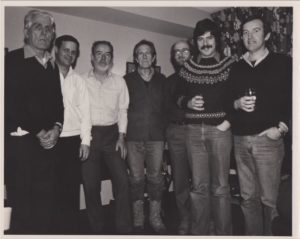
Cage w/The Chieftains & Robin & Russell
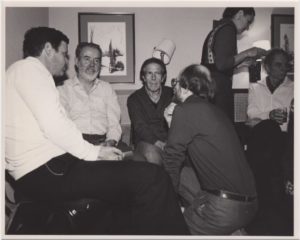
Robin, Paeder, John Cage, Russell, Merce Cunningham far right.
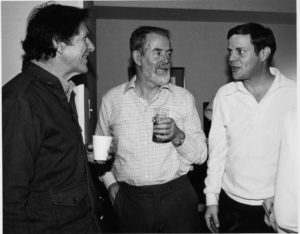
John Cage, Paeder Mercier & Robin
1982 CRAZY CAGE YEAR We participated in the North American premiere of Cage’s Roaratorio: an Irish Circus on Finnegan’s Wake on January 29 and 31 at Convocation Hall in Toronto in two concerts organized by Robert Aitken and New Music Concerts. Cage and Merce Cunningham were in the audience. We opened each of the concerts with a performance of Third Construction. Bob played the cowbell part, Robin played the lion’s roar part, Bill played the conch shell part and Russell played the log drum part. (After Robin left the group, Garry who had played the conch shell part with Blackearth, learned the lion’s roar part.) @RussellHartenberger says, “Cage hadn’t heard the piece for many years, possibly since he played it with his own group in the ‘40s.” We played it for him at the dress rehearsal and he had two comments: “The first was that it sounded more transparent than he had remembered. This could have been because his original performance were with non-percussionists, so we may have made the parts more clear than his performers did.” Bob talks about the 2nd comment: “I had chosen to use two medium size almglocken for the cowbells in my part – A and Eb, and I had them and my tin cans on a carpet-covered table top, so they could ring somewhat. I was trying to avoid the cliché jazz cowbell sound. Cage said: “This piece is not about resonance,” looking at my almglocken. He didn’t say “good” or “bad”. In fact, I can’t remember ever hearing him use either of those words in relation to anything. I still use those same almglocken when we play the piece now.” When Merce and Cage came up on the stage after the performance, “Merce was crying – he said it was the first time he heard the rhythms played correctly (and he had played in the premiere of the piece).” Robin also remembered Merce’s tears: ‘”This is the part I played,” he said to me, referring to my lion’s roar, ratchet and maracas etc.”
Russell explains that in Roaratorio, Cage read from James Joyce’s Finnegans Wake amidst the music of members of the Chieftains (Joe Heaney, Paddy Glackin, Seamus Tansey, Liam óg Ó’Floinn, Peader and Mel Mercier). “On the 1st night of the 2 performances there was a full house of 1,300. On the 2nd night there was a huge snowstorm but even so, about 800 people made it, including some who arrived on cross-country skis. Cage and the Irish musicians loved partying, so a big reception was arranged after the last performance a few blocks away…I had the good fortune of giving Merce a ride to it in my Volkswagen beetle.”
Paul Zukovsky conducted and recorded Cage’s Sixteen Dances at the Celtic event. We performed it with Robert Aitken, Otto Armin, Peter Schenkman, Jim Spragg and Marc Widner. The recording is available in the CP2 catalogue: http://www.musicalobservations.com/recordings/cp2_112.html
We performed it twice more with Paul in November’82 in Symphony Space, NYC and for a Cage Celebration at the Kennedy Center, where John, Robin, Russell and Bob also played Cage’s Branches. Robin tells the tale: “We discussed Cage’s performance notes which I understood to mean each of us was to toss the iChing coins to determine how we would interpret our parts. One of our head strong members objected to this reading and insisted we toss the coins just once to arrive at a group interpretation. We tossed one series and played. Cage later said, “Nexus does things their own way. They played Branches linearly, not the way I intended.” …My respect for Cage blossomed and as well, his comment provided me an ah ha, I told you so moment.” Bob Becker agrees: “Besides the unusual orchestration, Branches also requires that the performers determine in advance various temporal dimensions by chance methods, typical of Cage’s work during the 1960s and 70s…There was a serious debate…Cage himself wasn’t present during this discussion…following the performance he let us know that we had chosen the incorrect method. As it turned out, Robin had argued for the correct approach, but had lost by a vote of three to one.”
Read Cage’s full itinerary in Toronto and performers list for both the January Toronto event and the November Kennedy Center event can be seen at A John Cage Compendium: Chronology 1972-1992: https://cagecomp.home.xs4all.nl/chronology_1972-1992.html.
Read more: RobinEngelman.com blog post, “Cage Encounters”
Bob Becker’s blog post: https://www.nexuspercussion.com/2015/09/some-reflections-on-john-cage/
Russell Hartenberger’s “Encounters with John Cage”, Percussive Notes Sep 2012.
Robert Aitken recalls the Roaratorio performances in a 2009 The WholeNote interview: https://www.thewholenote.com/index.php/newsroom/feature-stories/2389-multi-faceted-robert-aitken

I have this painting of hands holding dove signed CRADEN